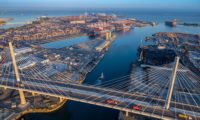As ships get bigger and faster, their wakes are putting increasing stresses on moorings of nearby vessels, causing some to break free—with potentially disastrous consequences.
Now, an international group of organizations has gathered in the Netherlands to develop software to calculate and mitigate wash effects of passing ships to improve port design and operations.
With the three-year Research on the Passing Effects of Ships (ROPES) project now two-thirds finished, engineers in Rotterdam plan to validate it with a final set of full-scale ship trials later this month. The Port of Rotterdam is one of 26 organizations— including design firms, other port operators and equipment makers—that are jointly sponsoring ROPES. The only contractor in the group is San Francisco-based Bechtel Inc., which joined after recruiting Marco Pluijm from the Amsterdam port authority, where he was head of development. Pluijm is chairman of the ROPES project and manager of Bechtel's new London-based, port- sector development unit.
The ROPES software will simulate the forces exerted on moorings by linking the forces to passing-ship sizes and velocities in different water conditions. It will let designers evaluate proposed port configurations for wash impacts, says Henk van den Boom, head of trials and monitoring at the Maritime Research Institute Netherlands, Wageningen. He is overseeing the ship tests for ROPES. Using the new software will also lead to more efficient use of existing ports, “saving a lot of acreage”, he adds.
In the absence of centralized data on wash effect incidents, ROPES chairman Pluijm relies on personal and anecdotal evidence when he says “globally it's a massive thing”. He cites an accident this September in Santos port, Brazil, as an example of the risk. In that case, the 225-m-long bulk carrier Yusho Regulus caused havoc after its ropes broke while bobbing in the wake of a passing ship.
As at other ports, assessing the risk of wash effects has been done from first principles each time, often using model tests, says Herm Jan Van Wijhe, Port of Rotterdam's project manager for planning and development. “There was no suitable program to do it by calculation,” he adds. He expects the ROPES software to change all that.
Bechtel's Pluijm believes the ROPES software will help Bechtel expand its role in the port procurement beyond construction alone. “We want to be involved ... much earlier than at present,” he says. The price of entry to the ROPES project was relatively modest, with Bechtel sharing the $1.3-million industrial contribution, augmented by a $650,000 Dutch government grant.
The ROPES project team now is validating the new mathematical models with a series of 1:100 test in the Rotterdam wave tanks of the hydraulics research organization Deltares N.V. Previous work in this field has been “case by case”, says Deltares's project adviser, Martijn de Jong. ROPES testing is “generic” he adds.
Complementing the wave tank studies are four sets of full-scale trials, says van den Boom. The first three full-scale tests took place in a container terminal, on a flowing canal and in an inland terminal. The last trial, due to last some three weeks from late November, will take place at Rotterdam's Caland Canal, and will investigate wash effects of a moving ship on two tethered vessels transferring fuel oil.
The software is scheduled for release next November. Initially it only will be available for use by its sponsors, but it will become freely available three years later.
New Software Models the Wrenching Forces of Ship Wakes in Port Environments

Tests in The Netherlands model ship wakes at 1:100 scale. Results are being validated with real ships at full scale
Photo by Peter Reina

Bechtel's Marco Pluijm is chairman of the ROPES project
Photo by Peter Reina

A consortium in the Netherlands is validating software designed to model the increasing forces of passing ship wakes on moored vessels to improve port design and operations
Photo courtesy of MARIN



Post a comment to this article
Report Abusive Comment